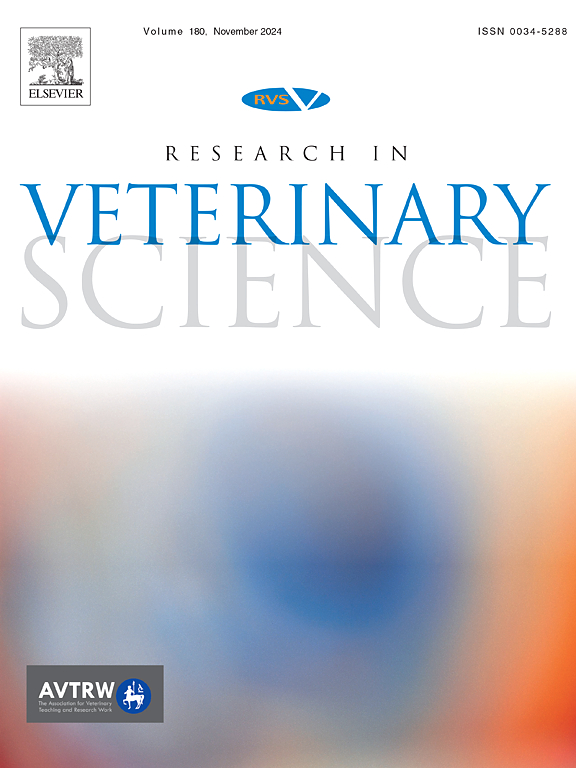优化牛去势急性疼痛诊断的行为红旗
IF 2.2
3区 农林科学
Q1 VETERINARY SCIENCES
引用次数: 0
摘要
Unesp-Botucatu牛疼痛量表(UCAPS)在实验环境中被广泛使用,然而,大量的UCAPS行为可能对其在农场或医院的日常实施构成障碍。我们的目标是确定一个较小的UCAPS行为组合,可以用作优化牛急性疼痛诊断的行为红旗。我们假设一组特定的UCAPS行为可能被用作疼痛的行为危险信号。这将代表一种快速和简单的疼痛评估,并可能优化大规模系统的急性疼痛评估。使用了先前两项关于59头雄性牛手术阉割前(无痛状态)和后(疼痛状态)UCAPS评估的研究数据。我们拟合了一个决策树,得到了一个包含两种行为的逻辑,我们将这两种行为用作行为红旗。当活动得分为2时,从决策树改编的逻辑考虑了痛苦的诊断。当活动度得分低于2分,但运动得分为1或2分时,诊断也被认为是疼痛阳性。当活动度低于2,运动为0时,诊断为无疼痛。预测UCAPS诊断的行为红旗曲线下面积为95.95%,预测整体无疼痛和疼痛状况的行为红旗曲线下面积为94.13%。综上所述,决策树逻辑中的行为可以作为优化牛急性疼痛诊断的行为红旗,作为大规模系统中的快速评估。本文章由计算机程序翻译,如有差异,请以英文原文为准。
Behavioral red flags for optimizing castration-induced acute pain diagnosis in cattle
Unesp-Botucatu Cattle Pain Scale (UCAPS) is widely used in experimental settings, however the high number of UCAPS behaviors might represent a barrier to its implementation in the farm's or hospital's routine. We aimed to identify a smaller combination of UCAPS behaviors that could be used as behavioral red flags for optimizing the acute pain diagnosis in cattle. We hypothesize that a specific set of UCAPS behaviors might be used as behavioral red flags for pain. This would represent a quick and simple pain evaluation and might optimize the acute pain assessment in large-scale systems. Data from two previous studies regarding UCAPS assessments before (pain free condition) and after (painful condition) surgical castration of 59 male cattle was used. We fitted a decision tree, resulting in a logic with two behaviors that we used as behavioral red flags. The logic adapted from the decision tree considered the painful diagnosis when the Activity was scored 2. When Activity was scored less than 2, but Locomotion was scored 1 or 2, the diagnosis was also considered positive for pain. When Activity was below 2 and Locomotion was 0, the diagnosis was considered free pain. Behavioral red flags had an area under the curve of 95.95 % for predicting UCAPS diagnosis and 94.13 % for predicting overall pain free and painful conditions. In conclusion, behaviors in the decision tree logic can work as behavioral red flags for optimizing the acute pain diagnosis in cattle, as a quick assessment in large-scale systems.
求助全文
通过发布文献求助,成功后即可免费获取论文全文。
去求助
来源期刊

Research in veterinary science
农林科学-兽医学
CiteScore
4.40
自引率
4.20%
发文量
312
审稿时长
75 days
期刊介绍:
Research in Veterinary Science is an International multi-disciplinary journal publishing original articles, reviews and short communications of a high scientific and ethical standard in all aspects of veterinary and biomedical research.
The primary aim of the journal is to inform veterinary and biomedical scientists of significant advances in veterinary and related research through prompt publication and dissemination. Secondly, the journal aims to provide a general multi-disciplinary forum for discussion and debate of news and issues concerning veterinary science. Thirdly, to promote the dissemination of knowledge to a broader range of professions, globally.
High quality papers on all species of animals are considered, particularly those considered to be of high scientific importance and originality, and with interdisciplinary interest. The journal encourages papers providing results that have clear implications for understanding disease pathogenesis and for the development of control measures or treatments, as well as those dealing with a comparative biomedical approach, which represents a substantial improvement to animal and human health.
Studies without a robust scientific hypothesis or that are preliminary, or of weak originality, as well as negative results, are not appropriate for the journal. Furthermore, observational approaches, case studies or field reports lacking an advancement in general knowledge do not fall within the scope of the journal.
 求助内容:
求助内容: 应助结果提醒方式:
应助结果提醒方式:


